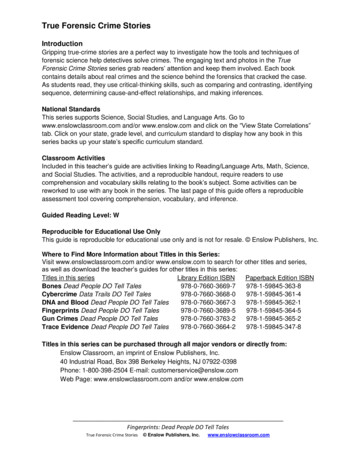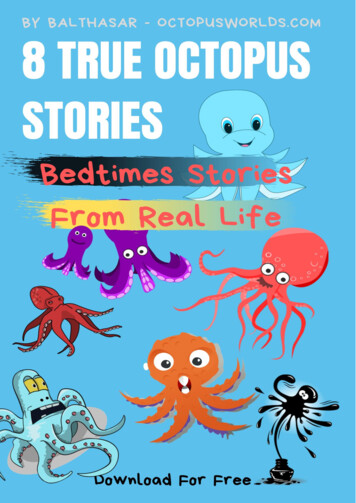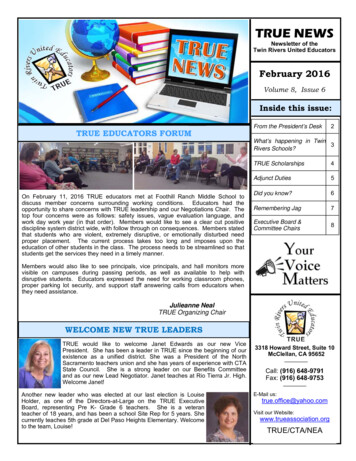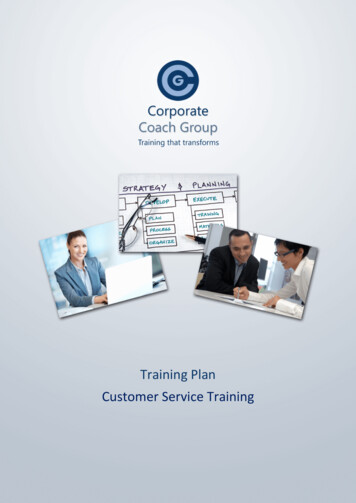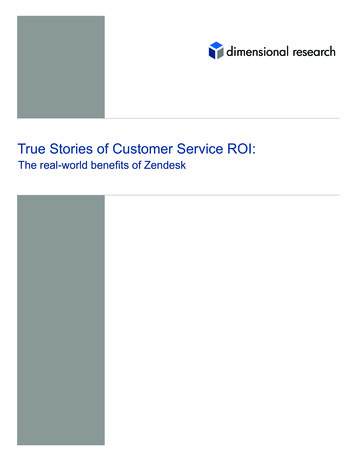
Transcription
True Stories of Customer Service ROI:The real-world benefits of Zendesk
IntroductionAny manager whose business thrives when customersare happy immediately understands the value ofexcellent customer service. The connection betweencustomer satisfaction and future revenue is wellestablished. The business challenge lies in providingexceptional customer service while at the same timemaintaining cost-effective operations. The systemused to support customer service has a significantimpact on both business outcomes and costs.Based on in-depth interviews with Zendesk customers,this paper investigates the value that customers havereceived from their investments in Zendesk, a cloudapplication for better customer service.These customers reported significant, measurableoperational savings from their use of Zendesk,in addition to gaining a wide range of qualitativebusiness benefits. Frequently reported areas ofquantifiable value include: Increased agent productivity Decreased ticket volume Avoided costs for in-house deploymentThis paper also considers other key benefitsexperienced by Zendesk users including increasedvisibility, accountability, better customer service, andflexibility.Quantifying the ROI of ZendeskMany customer service organizations that want toinvest in their systems must build a business caseto justify the cost. Typically that business casemust include detailed financial impacts. The goalof this paper is to identify the most straightforwardmonetary impact of Zendesk in order to supportbusiness case development.It should be mentioned that monetary savings arenot the first thing that customers talk about whenthey discuss the value they receive from Zendesk. Itcan be hard to put a clear dollar value on the mostimportant benefits: increased customer satisfaction,management visibility, data that informs betterbusiness decisions, happier agents, and so on.www.DimensionalResearch.com“Quantify the ROI of Zendesk? That wouldbe the same as the ROI for oxygen. Ourcustomer service team, and our business,can’t live without it.”That said, it is very easy to make a numbers-basedcase for Zendesk by focusing on the easily calculatedmetrics of agent productivity, service ticket volumes,and total solution costs.1. The ROI of Increased Agent ProductivityHeadcount is the biggest cost for customer serviceorganizations. While the companies in this studyunderstood the need to deliver excellent customerservice, there was not an unlimited pile of money tohire their way to excellence. Managing headcountcosts while maintaining the highest standard forcustomer service is a key driver for the Zendeskinvestment. As one participant said, “We can’t justcontinue to hire and hire to help our customers.Zendesk provided clear ways to improve ourprocesses and be more efficient without sacrificingexcellent service.”Zendesk customers report their biggest and mostimmediate cost savings from simply making it easierfor an agent to answer a ticket. Although Zendeskhas several features that increase productivity,two features came up consistently as particularlyimpactful when customers discussed the system’sROI.First, customers realized tremendous savings fromusing the built-in workflows with automated actions.Reducing the number of steps to resolve a customerinquiry allowed the same number of agents to handlemany more tickets.This feature was particularly appreciated bycustomers who had experience with other customerservice solutions before purchasing Zendesk. Otherproducts require an agent to jump through manyunnecessary and time-consuming steps: go to aqueue, click an item, read some details, click again toassign it, click to save the assignment, then to go theirown ticket list, click again, open another page to typea response, and so on and so on.True Stories of Customer Service ROI2
The Zendesk interface was thoughtfully designed to enable the sameresponse in only a few steps. Customers frequently reported that they wentfrom 8–12 steps to resolve a typical service request in a prior product toonly 2–3 steps in Zendesk.“It took eight minutes to log a ticket in the old system; withZendesk it takes two minutes to do the same thing. It’s amassive benefit in terms of time and efficiency.”The second Zendesk capability mentioned frequently in ROI discussionswas the ability to easily create a ticket from any channel of inquiry—website, phone, email, chat, or even social media. This capabilitystreamlined responses to customers who communicate with multiplemethods, as well as reducing the need to manually log inquiries.“Before Zendesk, customers could call or send emails to any of24 different departments. We discovered more than one instancewhen we had 10 different responses to the same inquiry! NowZendesk creates one ticket owned by one agent.”“All our service channels automatically feed into Zendesk. Youcan tie calls in and generate tickets. This is so much better thanmanually logging calls, which is just not fun for anybody.”The ways in which Zendesk delivered dramatic increases in agentproductivity was clear to customers, and this clarity enabled a straightforwardcalculation of financial impacts. Actual productivity gains depended heavilyon what was being done before. In cases where Zendesk was the first system,productivity typically increased by 50–70%. When Zendesk replaced anothersystem, typically productivity gains were reported at 30–35%.“We had a solid 35% increase in the number of cases we could handlewith the same team, just by cutting the manual clicking and typing.”“Our business has grown so much during the last six monthsthat without Zendesk we would have needed to hire 3 or 4 morepeople in addition to the 12 we have on the team now. We’vebeen able to keep headcount flat.”“Before Zendesk, we were averaging six contacts per hourper agent. Now we’re at eight. I want to be clear that we’re notPROJECTMETHODOLOGYZendesk commissionedDimensional Research tointerview active customersin order to obtain in-depthfeedback on the actual valuereceived. Dimensional Researchconducted telephone interviewswith Zendesk customers, andthis report is a summary of thoseconversations.Zendesk secured the participationof customers for the interviews,then passed their contactinformation to DimensionalResearch. Zendesk did notparticipate in the interviews.All content in this report wastaken from interview transcripts,although some quotes havebeen edited for grammar andreadability.Participants were notcompensated for participating inthis research project, althoughas a token of appreciation fortheir time, a donation was madeto a charity of their choice. Toencourage honest and unfilteredfeedback, participants wereensured anonymity.PARTICIPANT PROFILEThe participants are allresponsible for managingcustomer services teams andactively use Zendesk as theirmain customer support solution.The end customers supported bythese teams included consumers,businesses, and internalemployees.The customers worked in a widerange of industries includingretail, real estate, education,software, hospitality, non-profitand more. This global studyincluded participants from theUnited States, Europe, andAustralia.trading off speed for quality. Our single-contact resolution hasactually increased at the same time.”3True Stories of Customer Service ROIwww.DimensionalResearch.com
To assign a dollar value to these productivity gains,Zendesk customers used a simple calculation:productivity gains multiplied by headcount costs.ticket reduction, then ongoing, smaller reductions asthey continued to address their biggest issues.For example, without Zendesk one participant wouldhave needed to hire more than four agents to handleincreased business. With Zendesk, he was able tostay at his existing count of 12 agents. His calculatedsavings just from agent productivity was the fullyloaded cost of four additional agents, which for hisbusiness would have been around 200,000.# of agents without Zendesk16# of agents with Zendesk12Headcount hiring avoided4Fully loaded agent annual cost 50,000Annual agent productivity savings 200,000Another participant applied a “% improvement inproductivity” calculation to quantify savings. WithZendesk, each agent could handle 33% more ticketsper hour. When multiplied by the total headcountcosts, the annual agent productivity gain fromZendesk has a value of over 350,000.Annual headcount costsImplementing the support page with theknowledge base, we immediately saw a7–10% reduction in incoming contacts. Nowwe have an ongoing philosophy of findingnew ways to reduce tickets and streamlineworkflows. You’re never done with thisprocess, and we’re always getting better.”However, savings in this area varied widelydepending on the business. Gains from ticketdeflection could be significantly higher, as seen byone Zendesk customer, a software company that hadjust released a new product. They used Zendesk togather customer feedback and recommendations thatled to new knowledge base articles and even productchanges that ultimately reduced tickets by 70%.“We didn’t have much in place to handle 1,100,000% productivity gains with Zendesk33%Annual agent productivity savings 366,300issues proactively and the ticket load wasgetting out of control. It was getting to theplace where we couldn’t do anything butcustomer support. So we used Zendesk’srecommendations for topic suggestions and2. The ROI of Decreased TicketsAll customers in this study felt they could justifytheir investments in Zendesk based only on agentproductivity gains. However, another important andeasily measurable area of savings is proactivelypreventing tickets, called “ticket deflection.” Thesesavings are enabled by two key Zendesk Help Centercapabilities: A self-service knowledge base Customer feedback and recommendations70% of tickets dropped almost overnight.The remaining requests were the real issueswe wanted to spend time on.”To calculate the savings from decreased ticketsor “ticket deflection,” customers used this simplecalculation:Cost per ticket times # of tickets preventedFor service departments that serve consumers, thecost per ticket was frequently lower, but the volumeof tickets that could be prevented with Zendesk wasvery high.“Using Zendesk, you can really pinpointthings you shouldn’t have your peopledealing with anymore.”Cost per ticket (B2C)For most companies, their first efforts at self-serviceand ticket deflection create an initial impact of a 5–25%www.DimensionalResearch.com“Zendesk powers our external support page.# of tickets prevented (B2C) 950,000Savings from ticket prevention (B2C) 450,000True Stories of Customer Service ROI4
For customer service departments in B2B companies,the number of tickets to be deflected was lower, butthe cost per ticket was often much higher, resulting insimilar savings.Cost per ticket (B2B)# of tickets prevented (B2B) 355,000Savings from ticket prevention (B2B) 175,000the product. Anytime new functionality was required,each new Zendesk capability was considered veryinexpensive to implement.“With our prior product, I had to work with theadmin plus a programmer to do somethingas basic as getting a better report to view thetypes and timing of tickets coming so I could3. Cost Avoidance for Implementationand Maintenancebuild out our scheduling. And even then itOn their own, the metrics for productivity gains andticket deflection more than justified the Zendeskinvestment for all participants. However, one othersavings metric was also important when comparingZendesk to other solutions: the cost of purchasing,implementing, and maintaining in-house systems.Customers mentioned a few areas where Zendeskoffered lower total cost of ownership than alternativesolutions including:able to do the same thing with Zendesk in Very low implementation costs No cost of ongoing IT maintenance Savings from use of existing integrationsParticipants who had experience with other customerservice solutions were quick to emphasize that Zendeskhad the lowest implementation costs of any solutionthey had reviewed. Several participants were able to dothe entire implementation with in-house resources, andthose who did pay for consultants described severaldays of time with Zendesk, compared to weeks ormonths with other solutions they considered.“It took just over a day to set up Zendesk forour environment. There was no additionalcost except a bit of time, and you don’t haveto be a technical person to set it up.”“We had a consultant in for two days andwe were ready to go. So much easier thanour last experience, when we spent over 20,000 and it took three months to get thesystem up and running.”These lower costs continued past the initialimplementation through the full ownership cycle for5would take two months to get it done. I wasfour minutes.”Integration with other products was another areawhere customers avoided significant costs by usingZendesk. As a rule of thumb, participants budgeted atleast 5,000 for each integration they wanted to use.With Zendesk, these integrations were already writtenand freely available.“We recently got the Salesforce integrationfrom the apps forum. It took us 30 minutes tobe integrated.”“Integrations are a big part of the value.Zendesk has an enormous library of prewritten integrations that just plug in. Everyintegration we’ve tried has been up andrunning in just a few hours at the most,and we haven’t spent a single dollar onconsultants to do integrations.”When considering ROI, several participantscompared Zendesk to an existing on-premisessolution. Part of the ROI calculation was the abilityto eliminate current costs of hardware, software,and labor for the servers that hosted their customerservice solution.“Because Zendesk is a SaaS-based product,you don’t have to worry about simply keepingthe lights on. Take administration costs out ofyour proposal and zero out the line items forprofessional services and consulting.”True Stories of Customer Service ROIwww.DimensionalResearch.com
The calculation comparing the cost of Zendesk to an on-premises solution typically looked something like this:Consultants - implementationServersYear 1 TotalZendeskOn-premises 2,000 30,000 0 15,000 2,000 45,000Year 1 Zendesk Savings 43,000Consultants - annual ongoing 0 5,000Annual system maintenance 0 5,000Ongoing Annual Total 0 10,000Ongoing Annual Zendesk SavingsTotal Zendesk Savings 10,000Year 1: 43,000; then 10,000/yearIf the comparison of Zendesk was to a different hosted solution, the calculation would look like this:ZendeskOther hostedConsultants - implementation 2,000 30,000Consultants - annual ongoing 0 5,000 2,000 35,000TotalZendesk savingsYear 1: 28,000; then 5,000/yearBonus: The Non-Quantifiable Benefits of ZendeskParticipants reported they were easily able to demonstrate a substantial return on their Zendesk investmentwith just a few key metrics. However, participants were consistently unwilling to limit the ROI discussion to aconversation just about the numbers. While our original line of questioning focused very specifically on hardROI, the customers in this study went out of their way to emphasize the softer, qualitative benefits of usingZendesk including: Increased visibilityAccountabilityBetter customer service and increased revenuesFlexibilityIncreased visibilityCustomers were very enthusiastic about the operational visibility that Zendesk reports offer in several keyareas. Customers frequently mentioned the ability to make better decisions as a result of better information.“Before Zendesk I didn’t have data. Now I have data. I make better decisions. I know how manytickets employees can handle. I know who is most efficient and which of my people are better. Ihave the knowledge to assign the right people.”www.DimensionalResearch.comTrue Stories of Customer Service ROI6
“I use Zendesk data to be a much better“Zendesk gives us instant insight into whatmanager. I look at how productive everyoneis going on. We don’t have jobs sitting in ais on a daily and weekly basis and if aqueue or staff that doesn’t know where stuffperson is a rock star. I do incentive schemesis anymore.”and measure agents on both the quantityand quality of their results.”Zendesk is seeing immediately the problemsAccountabilityVisibility also leads to accountability. Having clearownership of issues, along with documentation ofwhat has been done, leads to better customer service.Participants emphasized that the accountabilityenabled by Zendesk helped the reputation ofthe service organization since they could alsodemonstrate their accountability.“Simple things like having a fact-basedconversation. If a VP calls and asks us abouta customer, we can say ‘we did these threethings on these dates and had this reply.’ Weget right down to business issues now insteadof arguing about who did what and when.”“Our customers are very happy withZendesk. Before we implemented it,customers felt that submitting a ticket wasjust a black hole. Now they can submit issueseasily and track what is going on with them.”“In the past, we had problems with theperception of the team. Zendesk haschanged those perceptions. That alonejustifies the subscription fee in my book.”Better customer service and increasedrevenuesThe customers in our study cared deeply about theircustomers’ experience and genuinely believed thattheir teams did a better job with Zendesk. Problemsdon’t get lost, the teams can be more proactive, andresults can be measured.7“One of the features I appreciate most inthat haven’t been resolved. We can beproactive and escalate ourselves, whichis a much better conversation to have witha customer.”No participant in the study was able to sayquantifiably that business growth was the directresult of this better customer service, but they allinstinctively knew that it played an important part.“We’re growing faster and doing bettercustomer service. I can’t measure theimpact, since we’re doing other thingsas well to drive business. But the entirebusiness is confident that excellent customerservice gives us an edge.”“We have 14 million more in revenue sinceadopting Zendesk. Marketing has done somethings too of course, but we know we havehad an impact.”“I can’t tell you the exact impact usingZendesk has had on revenue, but we doknow our customer satisfaction ratings havegone way up, and we know better customersatisfaction means more business.”FlexibilityHaving a hosted customer service solution allowedcustomers to consider supporting new and flexibleemployee arrangements, for example, working fromTrue Stories of Customer Service ROIwww.DimensionalResearch.com
home. These conversations came up as businessesevolved or needed to handle emergencies.“After Hurricane Sandy hit the East Coast,we had a lot of agents who couldn’t get tothe office. We got through it because theycould use Zendesk from home.”“As our business grew and we extendedour support hours, I didn’t want someoneleaving the office by themselves at 2:00 a.m.Zendesk lets our late shift work in the safetyof their homes, which makes them and mefeel better.”ConclusionThe participants in this study consistently reportedthat Zendesk’s solutions deliver real and substantialbenefits, although approaches to evaluating ROIvaried depending on the specific business needs ofeach company. Specifically, Zendesk customers sawclear, hard ROI in the following areas: Higher productivity levels for agents resultingfrom the Zendesk built-in workflows, automatedactions, and streamlined user interface Fewer tickets due to implementing self-servicecapabilities, identifying additional topics forthe knowledge base, and product improvementsbased on customer feedback Lower ownership costs from Zendesk’s simplerimplementation, integration, and maintenanceIn addition, participants saw many benefits that wereharder to quantify including: Increased visibility into customer serviceoperations Accountability for service issue ownership Better customer service through measurableservice activity Flexibility for telework and disaster recovery“There is no way not to justify a solution thatlets you be on top of your customerservice game.”www.DimensionalResearch.comTrue Stories of Customer Service ROI8
Example of Zendesk ROI – B2CAbout DimensionalResearchZendesk Savings# of customer service agents12Fully loaded annual cost of service agent 62,000Productivity savings from using Zendesk30%SAVING: Annual agent productivity savings 223,200Number of tickets annually32,000Cost per ticket 10Ticket reduction using Zendesk10%SAVING: Annual ticket deflection savings 32,000Zendesk Cost of OwnershipZendesk Enterprise annual license costs 18,000Services required for configuration and training 2,000Additional support costs, additional module costs,hardware costs, maintenance costs 0TotalInvestmentTotalSavingsNetSavings3-YearROI 56,000 765,600 709,6001267%Zendesk 3-year ROIExample of Zendesk ROI – B2BZendesk Savings# of customer service agents5Fully loaded annual cost of service agent 120,000Productivity savings from using Zendesk20%SAVING: Annual agent productivity savings 120,000Number of tickets annually10,000Cost per ticket 120Ticket reduction using Zendesk20%SAVING: Annual ticket deflection savings 240,000Zendesk Cost of OwnershipZendesk Enterprise annual license costs 7,500Services required for configuration and training 3,000Additional support costs, additional module costs,hardware costs, maintenance costsZendesk 3-year ROI 0TotalInvestmentTotalSavingsNetSavings3-YearROI 25,500 1,080,000 1,054,5004135% 2013, Dimensional Research. All rights reserved. www.dimensionalresearch.comDimensional Researchprovides practical marketresearch services that helptechnology companies makesmarter business decisions.Our researchers are expertsin technology and understandhow corporate IT organizationsoperate. We partner with everyclient to deliver actionableinformation that reduces risk andincreases customer satisfaction.Our research services deliver aclear understanding of customerand market dynamics. For moreinformation visitwww.dimensionalresearch.com.About ZendeskThis paper was commissionedby Zendesk, the leadingprovider of cloud-basedcustomer service software. Forgrowing organizations, Zendeskis the fastest way to enable greatcustomer service. More than30,000 Zendesk customers,including Gilt Groupe, Box,and Disney, trust Zendesk withtheir most valuable assets:their customers, partners, andemployees. Learn more atwww.zendesk.com.
"Before Zendesk, customers could call or send emails to any of 24 different departments. We discovered more than one instance when we had 10 different responses to the same inquiry! Now Zendesk creates one ticket owned by one agent." "All our service channels automatically feed into Zendesk. You can tie calls in and generate tickets.
